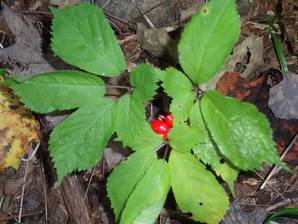Using a GPS is a good way to keep track of all those spots you find scouting this spring / summer for a hunting spot or that ginseng you found
Creating and navigating to a waypoint using your handheld satnav (GPS)
Importing Global Positioning Systems (GPS) data in Google Earth
The GPS unit I use https://buy.garmin.com/en-US/US/p/163
some software I use google.earth for pchttps://www.google.com/earth/download/ge/agree.html
google.earth for android
https://play.google.com/store/apps/details...
KMLZ to Earth for android
https://play.google.com/store/apps/details...
GPS Status & Toolbox for android
https://play.google.com/store/apps/details...
GPSBabel for pc
https://www.gpsbabel.org/
EasyGPS for pc
http://www.easygps.com/download.asp
BackCountry Navigator for android
https://play.google.com/store/apps/details...
Saturday, May 6, 2017
Thursday, April 13, 2017
ginseng cultural
Want to learn about ginseng cultural

then check out Appalachian Ginseng Hunters And Buyers Association web site also have a look at the FACEBOOK group where members share their photos knowledge techniques and allot more come join the fun also would like to give a very special thank you to the man that made this all come together Dr. Rick Lengyel, L.Ac.
Founder AGHBA come learn all about ginseng and grow with us at AGHBA

then check out Appalachian Ginseng Hunters And Buyers Association web site also have a look at the FACEBOOK group where members share their photos knowledge techniques and allot more come join the fun also would like to give a very special thank you to the man that made this all come together Dr. Rick Lengyel, L.Ac.
Sunday, February 12, 2017
West Virginia, with its extensive and diverse forests and bountiful rainfall, is an ideal region for the production of wild mushrooms. . .lots of them. In fact nearly 1,700 different species of mushrooms and other larger fungi have thus far been recorded for the state. This abundance includes some world-class prize edibles such as the Golden Chanterelle (Cantharellus cibarius), the King Bolete (Boletus edulis), and of course the eminently esculent Morels (Morchella spp.), of which there are about a half dozen varieties. Morels, which also go by numerous local names such as mollymoochers, haystacks, merkels, dry-land fish, and sponges, can only be found for an all too brief period in the spring (mid-April to mid-May), but dozens of other kinds of wild mushrooms, edible and otherwise,
This is an enjoyable outdoor activity, but it is not something to be taken casually as some mushrooms are poisonous. Unfortunately, there is no “rule of thumb” that can be used to separate the wholesome and delicious from others that are potentially dangerous if consumed. One common highly toxic mushroom that grows in summer and early fall is the Destroying Angel (Amanita virosa). This all white, innocent-looking mushroom has caused fatalities to some who have eaten it. Gathering wild mushrooms for the table is a rewarding pastime but you must know for certain which ones are edible and which are harmful. Those who want to forage for edible mushrooms should learn the safe edibles one by one, either from an experienced mushroom hunter or by studying mushroom field guidesLearn to identify fungi by downloading WVDNR's Mushrooms of West Virginia brochure.Click here to download the Mushrooms of WV Brochure
This is an enjoyable outdoor activity, but it is not something to be taken casually as some mushrooms are poisonous. Unfortunately, there is no “rule of thumb” that can be used to separate the wholesome and delicious from others that are potentially dangerous if consumed. One common highly toxic mushroom that grows in summer and early fall is the Destroying Angel (Amanita virosa). This all white, innocent-looking mushroom has caused fatalities to some who have eaten it. Gathering wild mushrooms for the table is a rewarding pastime but you must know for certain which ones are edible and which are harmful. Those who want to forage for edible mushrooms should learn the safe edibles one by one, either from an experienced mushroom hunter or by studying mushroom field guidesLearn to identify fungi by downloading WVDNR's Mushrooms of West Virginia brochure.Click here to download the Mushrooms of WV Brochure
Subscribe to:
Posts (Atom)


